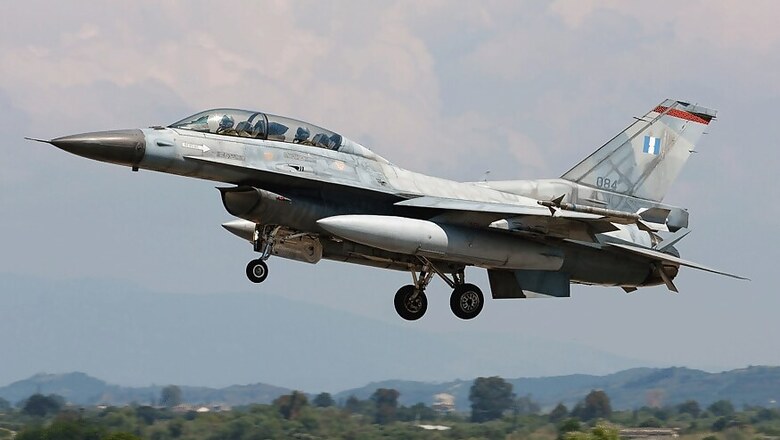
views
New Delhi: The Indian Air Force (IAF) has so far been largely dependent on Soviet-era aircraft such as MiG 21s and MiG 27s. So bad is the condition of these fighter jets that they have earned the ominous epithet “Flying Coffin” and “Widow-maker”. There have been at least 10 accidents involving MiGs over the last five years.
The entire fleet will have to be replaced with modern aircraft and a deal is in the works to buy 126 aircraft. What needs to be decided is which fighter jet India will buy. The choice is between The F 16 Block 70 produced by American firm Lockheed Martin and the JAS 39 Gripen E by Swedish company Saab.
The deal, whoever wins it, will be inked under Prime Minister Modi’s ‘Make in India’ doctrine. The aircraft will be manufactured on Indian soil. For the Make in India push, Lockheed Martin has tied up with Tata while Saab recently announced a partnership with the Adani Group.
News18 compares the two modern aircraft, one of which will become the mainstay of the IAF in the times to come.
F16: Pros
Perhaps the most battle-proven aircraft in the world, the F16 is currently in use by the air forces of 27 nations around the world. First put to use by the US Air Force in 1976, the F16’s major clients are the United States, its NATO allies and Pakistan. It has a length of 14.8 meters, a wingspan of 9.8 meters, a maximum take-off weight of 16,875 kg, a fuel capacity of 3,175 kg, a payload limit of 7,700 kg and can attain a maximum speed of 2470 km per hour.
The fact that the F16 has proven itself in battle over the years certainly means F16 would be the “safer” bet over the Gripen. Besides, Lockheed Martin has offered to sell the F 16 Block 70, the latest variant, to India. This means that in the event of a military confrontation, India would have a technical advantage over its regional rival Pakistan, which continues to use the Block 52.
From a ‘Make in India’ perspective, partnering with Lockheed Martin, the largest producer of defence equipment in the world, certainly has its advantages. The F 16 has a single supply chain, which means that the entire aircraft can be manufactured and assembled at one facility. During war time, aircraft can be produced at a much faster rate. Since the F 16 has a wider market, India would be able to sell not just aircraft but also spare parts to other parts of the world.
F16: Cons
Increasingly, Indian defense experts have started to worry that Lockheed Martin may be pushing old, obsolete technology on to India. Critics of the F 16 claim that it is an analogue aircraft in a digital age. The Block 70 may be its latest variant but the F 16 itself is over 40 years old and, according to many, leaves little room for modification. Since the F 16 was rolled out in 1976, Lockheed Martin itself has produced newer aircraft such as the F 22 Raptor. While relatively cheaper when compared to the Gripen, it has a higher operating cost and lower life cycle.
The Sensor technology of the F 16 is inferior to that of the Gripen. While the Block 70 may present a technological advantage over Pakistan in the event of an armed confrontation, it presents a strategic disadvantage since the Pakistan Air Force knows the F 16 aircraft better than the IAF and can plan accordingly. F 16s were first commissioned by Pakistan during the Soviet invasion of Afghanistan to counter both the Soviet Union and India. Since then, it has formed the bulk of the PAF fleet.
Besides, US President Donald Trump’s ‘America First’ policy may come into conflict with Modi’s ‘Make in India’. Washington may not allow Lockheed Martin to collaborate with India in a way that may harm the jobs market in the US.
Gripen: Pros
Produced by Sweden’s Saab, the Gripen E has a length of 15.2 meters, a wingspan of 8.6 meters, a maximum take-off weight of 16,500 kg, fuel capacity of 3,400 kg, a payload capacity of 5,300 kg and can attain a maximum speed of 2470 km per hour. It is one of the most advanced multi-role fighter jets in the world and is adept in all kinds of missions – air-to-surface, air-to-air and reconnaissance.
It also has one of the most advanced Sensor technologies in the world, which can come in handy in a dogfight or thwarting stealth missions, and a far superior radio communication system when compared to the F 16. Simply put, the Gripen is packed with modern warfare features, including a “digital cockpit” with a 3D screen.
It has a much lower operating cost and higher life cycle. The Gripen lends itself well to modifications and updates, which makes it ideal to replace the obsolete Soviet-era aircraft. Saab has also offered to manufacture a naval variant for India’s aircraft carriers. Currently, only four nations in the world use the Gripen in a major way – Sweden, South Africa, Czech Republic and Hungary.
Saab is a much smaller company than Lockheed Martin and hence, it needs the deal more than the American firm. This would give the Indian Government a better hand on the negotiation table.
Gripen: Cons
The difference in scale between Lockheed Martin and Saab is immense. As a company, the Swedish manufacturer is 1/13th the size of its American counterpart. Add to that the fact that the Gripen uses an American engine and it raises doubts over the effectiveness of the Supply chain that Saab hopes to set up in India. Lockheed Martin, on the other hand, can provide a single supply chain.
While the operating cost of the Gripen is less than that of the F 16 Block 70, the ‘per unit’ cost of each aircraft is much higher. Besides, it has not been proven in combat the way the F 16 has. The F 16 has been used extensively in battle and in wargames and a strategic partnership with an American firm may further bolster India-US relations. This is an advantage that Saab may not be able to provide.




















Comments
0 comment